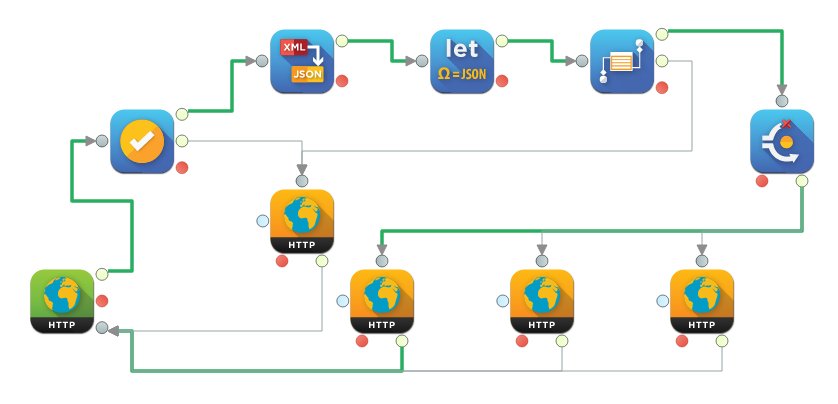The app is finally taking shape.
Data is sitting in your datastore.
Users are about to start bombarding the front-end with requests.
Quite a familiar scenario for any standard web/mobile app developer.
You have approached the Big Question:
How to get the balls rolling?
How to transform user actions into actual backend datastore operations?
One (obvious) way would be to build an ORM, configure a persistence provider (such as Hibernate-JPA) and link the pieces together through an MVC-style contraption.
But what if you don't want all those bells and whistles?
Or, what if all you need is just a quick 'n dirty PoC to impress your client/team/boss, while you are struggling to get the real thing rolling?
Either way, what you need is the "glue" between the frontend and the data model; or "integration" in more techy jargon.
UltraESB-X, successor of the record-breaking UltraESB, is an ideal candidate for both your requirements. Being a standalone yet lean runtime—just 9 MB in size, and runnable with well below 100 MB of heap—you could easily deploy one in your own dev machine, prod server, cloud VM, Docker, or on IPS, the dedicated lifecycle manager for on-premise and (coming up) cloud deployments.
As if that wasn't enough, building your backend becomes a simple drag-and-drop game, with the cool UltraStudio IDE for integration project development. Just pick the pieces, wire them together under a set of integration flows—one per each of your workflows, with interleaving subflows where necessary—and have your entire backend tested, verified and ready for deployment within minutes.
We have internally used UltraESB-X seamlessly with JPA/Hibernate, whose details we hope to publish soon—in fact, there's nothing much to publish, as it all just works out of the box, thanks to the Spring-driven Project-X engine powering the beast.
That being said, all you need right now is that QnD solution to wow your boss, right?
That's where the JSON Data Service utility comes into play.

Tiny as it may seem, the JSON Data Service is a powerful REST-to-CRUD mapper. It simply maps incoming REST API requests into SQL, executing them against a configured database and returning the results as JSON. Exactly what you need for a quick PoC or demo of your app!
We have a simple yet detailed sample demonstrating how to use the mapper, but all in all it's just a matter of specifying a set of path-to-query mappings. The queries can utilize HTTP path and query parameters to obtain inputs. SQL column name aliases can be used to control what fields would be returned in the response. The HTTP method of the inbound request (GET, POST, PUT, DELETE) decides what type of operation (create, read, update, delete) would be invoked. Of course, you can achieve further customization (adding/modifying fields, transforming the result to a different format such as XML, as well as audit actions such as logging the request) by simply enhancing the integration flow before the response is returned to the caller.
For example, here are some REST API operations, with their corresponding JSON Data Service configurations (all of which could be merged into a single integration flow, to share aspects like authentication and rate limiting):
Assuming
- a
bookAPI entity to be returned to the frontend:{ "name": "book_name", "author": "author_name", "category": "category_name" } - a
BOOKtable:( ID SMALLINT, NAME VARCHAR(25), AUTHOR_ID SMALLINT, CATEGORY VARCHAR(25) )
- and an associated
AUTHORtable:( ID SMALLINT, NAME VARCHAR(25) )
The following API endpoints:
| REST path | operation |
|---|---|
GET /books?start={offset}&limit={count} | return all books, with pagination (not including author details) |
GET /books/{id} | return a specific book by ID, with author details |
GET /books/search?author={author} | return all books of a given author |
could be set up with just the following data service configuration mapping (the rest of the steps being identical to those in our dedicated sample; just ensure that you maintain the order, and note the extra SINGLE: in front of the 2nd query):

| key | value |
|---|---|
/books/search?author={author:VARCHAR} | SELECT B.NAME AS name, B.CATEGORY AS category
FROM BOOK B, AUTHOR A
WHERE B.AUTHOR_ID = A.ID AND A.NAME = :author |
/books/{id:INTEGER} | SINGLE: SELECT B.NAME AS name, A.NAME AS author, B.CATEGORY AS category
FROM BOOK B, AUTHOR A
WHERE B.AUTHOR_ID = A.ID AND B.ID = :id |
/books?start={offset:INTEGER}&limit={count:INTEGER} | SELECT NAME AS name, CATEGORY AS category
FROM BOOK LIMIT :offset, :count |
See? Anybody with a basic SQL knowledge can now set up a fairly complex REST API, without writing a single line of code, thanks to the JSON Data Service!









